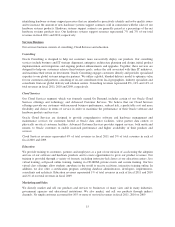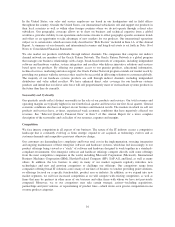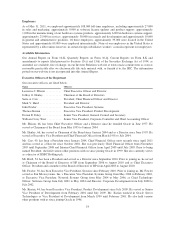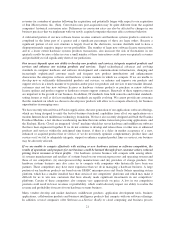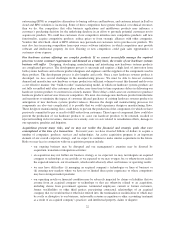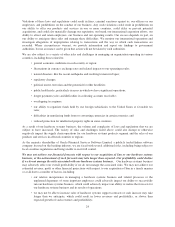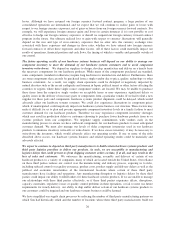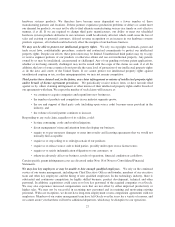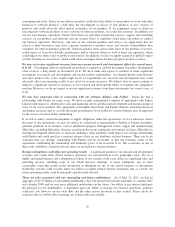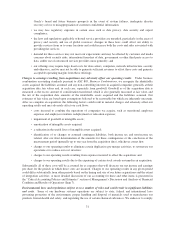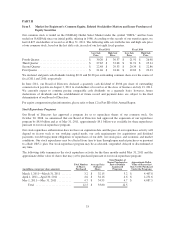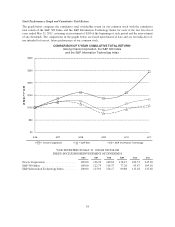Oracle 2011 Annual Report Download - page 27
Download and view the complete annual report
Please find page 27 of the 2011 Oracle annual report below. You can navigate through the pages in the report by either clicking on the pages listed below, or by using the keyword search tool below to find specific information within the annual report.• our hardware systems business has higher expenses as a percentage of revenues, and thus has been less
profitable, than our software business. We have reported, and may continue to report, lower overall
operating margins as a percentage of revenues, and we may not achieve our profit margin levels that
we attained prior to our acquisition of Sun;
• we face a greater risk of potential write-downs and impairments of inventory, higher warranty expenses
than we had historically encountered in our existing software and services businesses, and higher
amortization from, and potential impairment of, intangible assets associated with our hardware systems
business. Any of these items could result in material charges and adversely affect our operating results;
and
• we may forgo sales opportunities, customers and revenues as a result of our reducing the resale of third
party products and services for which Sun historically acted as a reseller.
Our strategy of transitioning to a mixed direct and indirect sales model for our hardware systems products
may not succeed and could result in lower hardware revenues or profits. Disruptions to our software indirect
sales channel could affect our future operating results. Although we will continue to sell our hardware
systems products through indirect channels, including independent distributors and value added resellers, we
have enhanced our direct sales coverage for our hardware products and intend that our direct sales force will sell
a larger portion of our hardware products in the future than they do now. These direct sales efforts, however, may
not be successful. Our relationships with some of our channel partners may deteriorate because we are reducing
our reliance on some of these partners for sales of our hardware products, are modifying our approach and timing
to the manufacturing of our products and are altering certain of Sun’s legacy business practices with these
channel partners, which could result in reduced demand from the channel partners or certain customer segments
serviced by these channel partners. Some hardware revenues from channel partners may not be replaced by
revenues generated from our own sales personnel or may not be replaced as quickly as we expect. In addition, we
may not be able to hire qualified hardware salespeople, sales consultants and other personnel for our direct sales
model at the rate or in the numbers we need to generate the hardware revenues and profit margins we have
projected for future periods. Even if we can meet our hiring needs, these salespeople may not be able to achieve
our sales forecasts for our hardware business. If we experience any of these risks, our hardware revenues or
profits may decline.
Our software indirect channel network is comprised primarily of resellers, system integrators/implementers,
consultants, education providers, internet service providers, network integrators and independent software
vendors. Our relationships with these channel participants are important elements of our software marketing and
sales efforts. Our financial results could be adversely affected if our contracts with channel participants were
terminated, if our relationships with channel participants were to deteriorate, if any of our competitors enter into
strategic relationships with or acquire a significant channel participant or if the financial condition of our channel
participants were to weaken. There can be no assurance that we will be successful in maintaining, expanding or
developing our relationships with channel participants. If we are not successful, we may lose sales opportunities,
customers and revenues.
We may experience foreign currency gains and losses. We conduct a significant number of transactions in
currencies other than the U.S. Dollar. Changes in the value of major foreign currencies, particularly the Euro,
Japanese Yen and British Pound relative to the U.S. Dollar can significantly affect revenues and our operating
results. Generally, our revenues and operating results are adversely affected when the dollar strengthens relative
to other currencies and are positively affected when the dollar weakens.
In addition, we incur foreign currency transaction gains and losses, primarily related to sublicense fees and other
intercompany agreements among us and our subsidiaries that we expect to cash settle in the near term, which are
charged against earnings in the period incurred. We have a program, which primarily utilizes foreign currency
forward contracts to offset the risks associated with these foreign currency exposures that we may suspend from
time to time. This program was suspended for part of fiscal 2011 but was reactivated during our second quarter
of fiscal 2011. As a part of this program, we enter into foreign currency forward contracts so that increases or
decreases in our foreign currency exposures are offset by gains or losses on the foreign currency forward
contracts in order to mitigate the risks and volatility associated with our foreign currency transaction gains or
25


